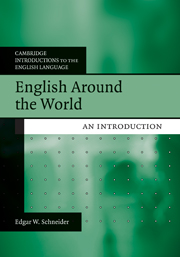Book contents
- Frontmatter
- Contents
- List of figures
- List of maps
- List of tables
- List of texts and audio samples
- Acknowledgments
- A note on using this book
- 1 Introduction
- 2 Basic notions
- 3 Historical background
- 4 Language crossing an ocean: Old World and New World
- 5 Settlers and locals: Southern Hemisphere Englishes, transported and newly born
- 6 Missionaries, merchants, and more: English is useful, English is ours
- 7 Language development: a general perspective
- 8 Issues and attitudes
- 9 Conclusion
- Appendix 1 Phonetic characters
- Appendix 2 A list of guiding questions on English in any specific region
- Glossary
- References
- Index
4 - Language crossing an ocean: Old World and New World
- Frontmatter
- Contents
- List of figures
- List of maps
- List of tables
- List of texts and audio samples
- Acknowledgments
- A note on using this book
- 1 Introduction
- 2 Basic notions
- 3 Historical background
- 4 Language crossing an ocean: Old World and New World
- 5 Settlers and locals: Southern Hemisphere Englishes, transported and newly born
- 6 Missionaries, merchants, and more: English is useful, English is ours
- 7 Language development: a general perspective
- 8 Issues and attitudes
- 9 Conclusion
- Appendix 1 Phonetic characters
- Appendix 2 A list of guiding questions on English in any specific region
- Glossary
- References
- Index
Summary
In this chapter …
In this chapter we will learn about the earliest and most deeply rooted processes of colonization which have shaped the English language, in what used to be known as the “Old World” and the “New World.” English itself is shown to be a product of colonization, namely of the settlement of the British Isles by Germanic tribes more than 1,500 years ago, similar to the effect on language of colonial expansion in the modern age. British English was influenced and shaped by contact with an indigenous language (Celtic) and with later “adstrates” (Scandinavian and French, mostly). We then look at the initial stages of the colonial diffusion of English in the seventeenth century, to North America (ultimately producing American English as we know it today) and to the Caribbean (with the forms of English found there being largely products of a major restructuring process, creolization). In each of these cases I will survey the general sociohistorical context and will then zoom in to a closer, exemplary discussion (including a text sample) of one characteristic regional variety of English found there.
Roots and early expansion: the British Isles
The growth and spread of British English
In the last chapter you read about colonization as a historical activity of European powers and about how this process of expansion, diffusion, and dominance came to an end in the twentieth century (but has left substantial traces to the present day). Certainly this was a distinctive phase in human history, and perhaps in its global extension it was a unique one.
- Type
- Chapter
- Information
- English Around the WorldAn Introduction, pp. 62 - 110Publisher: Cambridge University PressPrint publication year: 2010



